#kitagawa fram
Text
――芸術祭が増えていくのは全然構わないですか?
"構わないし、淘汰される。たしかに今後、いろいろ変化はあるでしょう。でも、良い芸術祭は続くだろうし、いまも増えています。日本でやっている100か200の芸術祭のお金を足したって、軍用ジェット機1台の価格より安いんじゃないか。何が問題なんだと思いますね。"
僕も含め、フラム氏の実践に疑問を持つ都市の研究者たちに。ともにこれからの社会の未来を考えるきっかけになるかもしれない、素晴らしいインタビューをとってくださった質問者にも感謝。
0 notes
Text
Art for Activation

Just like the word in “A Tale of two cities.”
“It was the best of times; it was the worst times, it was the age of wisdom, it was the age of foolishness…….We had everything before us. We had nothing before us; we were all going directly to heaven, We were all going direct the other way.”
I think this description does not only apply to the age of the French Revolution. But today’s as well.
It turns out, good and evil always are relative. Everyone should gently and sturdily embrace their time and shoulder on their responsibilities. Change the subject or state something positive in response could have a possibility of seeing a hopeful world.
The industrial revolution has resulted in the rapid evolution in human society which produces an enduring vision of the world and causes profound effects. The world is witnessing the coming of global contemporaneity. The continuous development leads to increasingly complicated relations in each field, environment, culture, history, economy, as well as politics and it seems to be going somewhere uncontrollable.
Under this circumstances, the contemporary art practised a pluralistic perspective could be as a valid strategy to activate the 'zones of silence', and this is the crucial point for change. Because art can be related to discovery, education, exchange and cooperation.
The following are the key points of the art engagement
Decolonisation
Reinhabiting
Contemporaneity
Site-specificity
Participation
In these part, I would like to combine my experience in Art field Japan with some theory to explore how art activates a community.
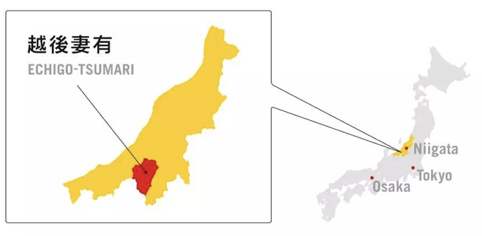
This area consists of 200 small villages, located in the southern region of Niigata, with a wonderful landscape. However, this area had been ever abandoned by the government.
From its name, we can see the situation.
Echi —— Uninhabited
Go—— Economic depression
So, what happened in the early 20th century.
youtube
This area is buried in the snow for more than six months of a year, and therefore it led to low production in agriculture and population loss. Due to the low-speed development, The villagers had lost their pride in their hometown and local culture. At the end of the 20th century, this area hadn’t entered into the automobile society yet, They had no sense of identity for a new city or a new country.
However, what this area looks like today. It has experienced a fantastic development and become the most outstanding example in the world. It is a favourite place in Japan and has held some international communication events.
youtube
why art was associated with this area in the 20th century, the government has tried to do many ways, but there was no effective improvement because of the four complicated problems: passive attitude, place identity, culture shock and decline of the economy.
In 1995, an art director Fram Kitagawa proposed a bold idea that public art is a valid strategy. He wrote this book to record the whole festival.
However, a challenge was that how could the young modern art be grafted on such an ancient farming civilization? No one believed that holding an art festival can help them to solve practical economic and social problems.
How art did?
Decolonisation
Gruenewald (2003a, p. 9)states that the significant factor involved in decolonisation is the development of the ability to recognise ways of think that injure and exploit other people and place.
Nikos Papastergiadis and Gerardo Mosquera (2014) mention that the vitality and value of culture rely on exchange and is benefited by communication.
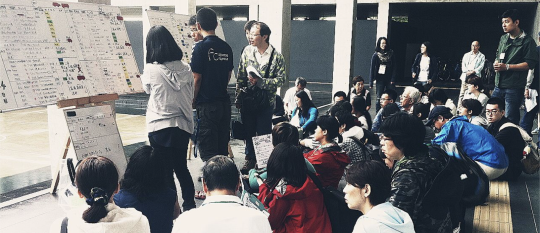
Therefore, communication is the top priority. It took Fram 7 years to publicize everywhere and organized a volunteer team “ Koheibi” that consists of young people from different backgrounds. Developing empathy in the relationship between them and residents.
It requires artists to see beyond the private and individual and establish a relationship with residents upon mutual interests and mutual respect.
Instead of dominating art to space, Art in this place should be a collective experiment which finally is responded actively and extended widely to a multicultural form.
Reinhabiting
'Reinhabition involves identifying, affirming, conserving and creating those focus of cultural knowledge that nurtures and protect people and ecosystem.’ (Gruenewald, 2003a, p. 9)
The typical feature of the social theory is that "the lack of interest in the place, material context and the land, the social science also tend to the generalization without the consideration of specific context. And this caused the placelessness in Modernity while postmodernity requires the recognition of the multiplicity of places. (Somerville 2010)
As the centre of experience, the local place explains how the world works and how their lives fit into the space they occupy. Therefore, it is necessary for residents to rediscover and rethink this place.
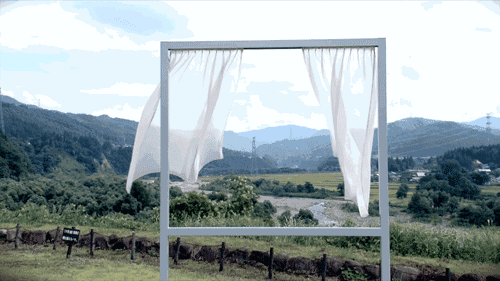
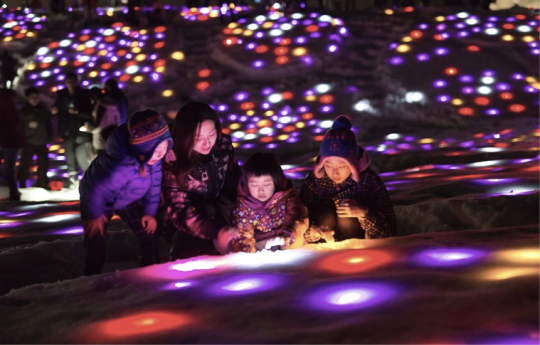
(Provided by Tokamachi City Tourist Association)
‘Gift for Frozen Village’ Takahashi Kamasata, 2012
Rethink the nature
It is important to rebuild the confidence of their hometown by rediscovering nature. This, in turn, can change their attitudes and make them rethink nature. Artists created a variety of artworks to reflect the beauty of nature, this is an example, this artwork names ‘Gift for Frozen Village’, artist fully utilized the snow’s features to combine with the people, fields and forest around, each resident was told to plant a LED “light seed” to bloom in the snow. Gradually, villagers were no longer afraid of the snow. Instead, they began to enjoy the snow and finally, they proposed a slogan “snow is our friend”.
A new view appeared in their familiar scene could draw more concerns, and it gradually benefits to the awareness enhancement as well as encourages the local residents rediscovering their environment, nature and civilizations, reviewing place values and a possibility of art and land. (Kwon 2004, p.66)
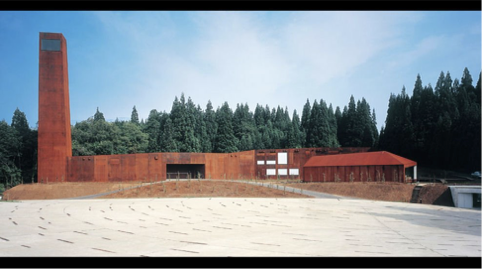

Learning about the resource
“Empty House” project
Artists point out to employ the empty house project that rebuilds the destroyed house and school and transform them into the natural resource museum.

photo credit: Echigo tsumari.jp
‘The Rice Field’, Ilya & Emilia Kabakov ,2000
Developing a sense of place and Recognition of the culture
Talking About the recognition of the culture. Integrating the local culture into artworks can help them to realize their own value: agricultural society
“The Rice Field”. Before the first art festival held, artists came here and were deeply touched by seeing farmers working hard among the snow in the early spring. So they set up coloured farmer images about farming in the farmland. In the meantime, they set up a viewing platform on the opposite of the rice field. With a poem which praises their farming culture.
Contemporaneity
It really differs from the Modernity, and it requires artworks bridge the gap among pastness, presentness and future, and this finally engages with the sensitive and incisive social issues of our time, to evoke some positive response. (Smith 2006)
Recording the changes in the multiple time series could draw more attention to the age of terror and prompt to an active confrontation throughout time, things, and thoughts (Bennett 2012).

‘The Rice Field’, Ilya & Emilia Kabakov ,2000
Reproduce life and reconstruct space had established a new relationship between man and man, man and field.
This work highlights the culture of this place but also draw the attention to develop the place image and enhance personal identity. Moreover, In scenes reminiscent of the cultivation, this work evokes the consideration of the current situation and explore a direct experience of multiple time series.
According to (Stephen 2015), more than 50% of farmlands had been reused in 2006, and almost 90% of the land was used in 2015.
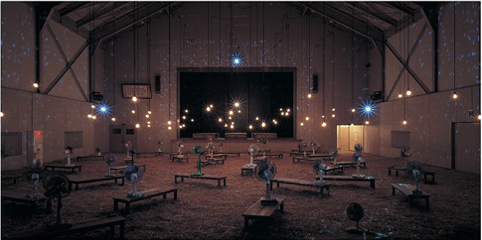
The last class, 2006
Review the history
This work is one of the ‘empty house projects’, and it was a school destroyed by a snowstorm. Now it has been rebuilt to reflect the difficulties of livelihood issues and the sustainability of education by the emphasis on the absence of children.

Windows are all in black, and the whole space is filled with the darkness. At the end of the corridor, there is a microphone amplifier with the sound of the heartbeat as well as flashing lights.

The desks and chairs stacked together and are covered with huge white cloth and projected the image with flower and fuzzy light spot. Faint light shakes through the darkness. The dreams of the past intertwine with memories, reminding the time and minds in that time. There were many young lives.

The deconstructive translation seems to increase the sense of empathy, which removes the specificity of identity and let our body to connect with the place.
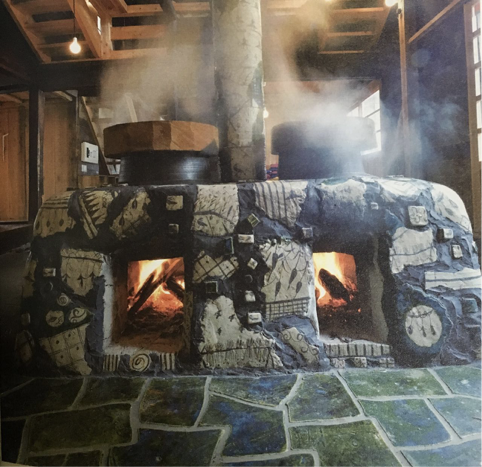
Ubusuna House Yoshitoki Irisawa and Kuhihiro Ando, 2006
Back to the past
Reuse the abandoned house and reappear the scene of life to evoke people’s memories.
Ubusuna House is inspired by life, ceramicists use local clays to draw a disused house, each surface of the objects in this area such as pit furnaces, stoves, roods and the floor has been decorated with ceramics. Originally it was artwork for exhibition and currently has been used as a restaurant. Artists invited women to manage these art houses and cook local food to tourists. This has created job opportunities for locals and attracted people to come back. No more is a personal house, it seems to be a heritage of community culture.
As traditional culture, ceramics carries on the history and memory, and the return of these residents also connect the pastness with the presentness.
It is reported that the number of population in Niigata increased from 75000 in 1990 to 800,000 in 2018. (Yoshiaki Ito)
Site-specificity & Participation
At the moment of global contemporaneity. Things and places are interrelated. Place as a connecting zone, requires the recognition of the multiplicity and complexity of places (Somerville 2010,p.327).
Although some parts of the memory in the place could be painful, there is no denying that place is the most productive. As a framework for creating, visual proofs rooted in physical reality might generate new story and memories. (Somerville 2010, p.328)
Art in combination with daily life could be the physical contact with the specific place which contributes to a public context and the alternative representation. This is also the chance to increase participation and connect society.

Gift for Frozen Village

Forest School
Consideration of the natural environment and culture value
Gift for Frozen Village and Forest School highlights the importance of the Site-specificity. They present the different functions of the snow as well as the utilise of the physical feature of the place.
The figure of forest school is abstracted by the snake to respond to the local field culture, and according to the surrounding geographical characteristics and weather conditions, its materials, colour and construction have been deeply considered. Made of the thick acrylic, windows can perfectly combine the building with the surrounding environment regardlessness of the change of season. The apparent colour and the huge figure can navigate the directions in the field and particularly in winter, it will be mainly covered by snow, but the snow wall is still visible. Nowadays, the school has been transformed into a natural science museum that displaying all of the wild animal specimens in this place and the traditional farming tools. The artist collected stories from villagers and cooperated with bioscientists to employ this project, transforming the abandonment of the school into a social environment that presents the value of countless personal, collective and agricultural history.
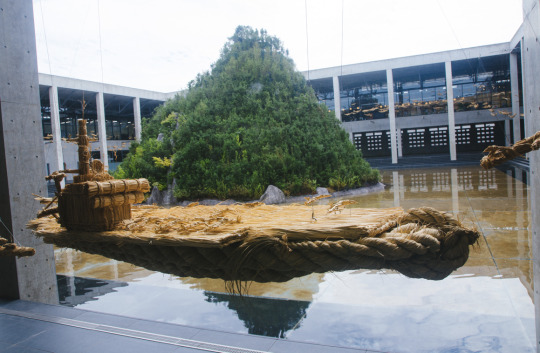
Cai Guoqiang, 2015 ‘Penglai island.’
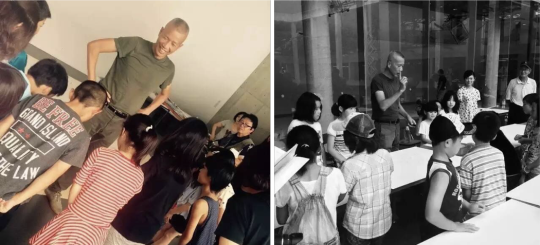

Participation and Education & Culture Sustainment
This is a collective experiment, Penglai island, which is organized by Cai, a Chinese artist. In China, Penglai is an ideal place where is peaceful and without any conflicts. He used Penglai island to describe Echigo, with different transportations made by children around it, when he designed it, he taught children to design different patterns, then invited old people who master the traditional handicraft techniques to teach children that use local materials to weave. And he just wanted to express that Echigo is a beautiful paradise and industrial society would not destroy it. This work exchanged the traditional culture of two different countries and also contributes to the protection and inheritance of traditional techniques.
The Transformation of place to art also involves the changes in spirit and recognition. Participation, as a contributor, is the significant factor to maintain sustainable communications and exchanges. (Bishop 2006, p67).
Walter Benjamin proposed that art can be explored into a social intervention and provide a means of producing which allows the multi-participation with viewers (Bishop 2006, p11).
Collective elaboration is the priority of art practice because the production is local and responsive. So art cannot be pre-empted to dominate before the local people sharing their stories. During the process of creating, the local story must be integrated. And this finally creates an active mode of production with the function of connecting a community and restoring the social bond.
youtube
In this tour, I learned and gained a lot. Before I came here, I have never thought of that Social engagement can be like this. The Most surprising is the participation and acceptability of art in here is so high. Travellers and volunteers come from all over the world, and local residents organize spontaneously to be the manager for protecting these art places. By now, more than a thousand artworks are permanently displayed in here.
In the closing ceremony, everyone was here, even the art festival director Fram Kitagawa and the mayor of Nigata. The interaction between us is really grateful and enjoyable, and I realize that art can create more possibilities and carry a lot of importance to the development of our life and future. under a state of passive reception, art might be our opportunity to break through, as it can connect life and culture, integrate all things together and prompt our thinking.
0 notes
Text
Ship Smoke, Lujiazui Harbor City, Shanghai
Cadillac House in Pu Dong, Shanghai Show Room, Commercial Project, Chinese Interior Architecture Images
Ship Smoke, Gala Mall, Lujiazui Harbor City
10 Sep 2020
Ship Smoke at Gala Mall, Lujiazui Harbor City, Shanghai
Architecture: CROX / C.R.Lin
Location: Gala Mall, near to the Yincheng Road, Lujiazui Harbor City, Shanghai, China
Ship Smoke
“ Engine is roaring, ship starts to vibrate, and sail swells out in the wind.
Ship smoke · curl upwards.
Adventure is going to start! ”
Ship Smoke is selected for Harbor City’s Worldwide Public Art design competition. The jury concludes Jean de Loisy, director of the Palais de Tokyo Museum, Andrea Schlieker, director of commissions and special projects at White Cube, independent curator Fang Zhenning, art director Fram Kitagawa, government recommended experts and client’s representatives. Ultimately, 17 out of 500 artworks were officially selected to be made and located on the Shanghai Lujiazui Harbor City street in 2020.
Currently, under the globalization situation, CROX wish each place could be more localized to reflect their culture and specialization. The new masterplanning of the Harbor City will be localized in Shanghai, a city that is full of culture, memorization and internationalization.
Thus, we wish to have proposals that can reflect the contemporary culture and diversity of the world. The application requirements are quite open, we are looking for some fun and high practicability artwork designs」Fram Kitagawa, curator of the exhibition, he declared the competition theme is “Exploration Ship Travels through the Space and Time”.
Ship Smoke is located on the north entrance of Shanghai Gala Mall (near to the Yincheng Road) and in front of the main building. CROX desired to connect to the oldship yard history while keeping its functionality.
The concept was inspired from the ship smoke’s dynamic air current. CROX retain the smoke on the basement of ship voyaging eastwards, keeping the ground and skyline horizontally, with a feeling of moving forward. The blank line, providing people with an upper and lower latitude imagination, symbolized a changing and developing city.
Mimicking the floating current artificially is an ideal natural romantic process. The stainless steel implies the immortal material world. Expressing the vivid air with a solid object and emphasized this magic city’s general changes in business through time. In Addition, it shows a reflection of Eastern culture’s reverence of nature and history. These provoking thoughts are derived from the way that people deal with the current living situations and corresponding responsibilities towards the future.
As a result, Ship Smoke symbolizes the inheritance of Oriental culture. Through this new artistic expression in architecture, CROX provide people with an aesthetic feeling and emotional experience toward the space. The combination between architecture and installation has stimulated its vitality, highlighting humanism in city development, achieving a comprehensive functional and spiritual utility.
Public art is the prospects of the future city, as well as an expression in the city’s individuality. As the only non-artist perspective that was selected among all the submitted works. CROX wish people could be acknowledged with the avant-garde architecture views, in addition, opening up new conversations between public and society.
Tracing back, CROX have created eight design works in total, besides “Ship Smoke”, including “Glisten”, “Through”, “Existing”, “Floating”, “Home Harbor”, “Soft Air”, “Wave Imprint” and “Impression”.
With a fun vision to echo Shanghai its unique charm. We try to bring out different views toward life, expecting to create a lively environment for people to live and encourage them to participate into the city artwork creation, furthermore, crossing boundaries between architecture and art.
Ship Smoke, Gala Mall, Lujiazui Harbor City, Shanghai – Building Information
Installation Name:Ship Smoke
Location:Gala Mall, near to the Yincheng Road, Lujiazui Harbor City, Shanghai, China
Client: CITIC Limited & China State Shipbuilding corporation
Leading Architects:C.R.Lin
Design Team: Sun Lidong, Wei Lu, Xin Chang hao, Ye Xiunan, Zhang Minzheng, Zhou Tian ye
Completion time:Aug, 2020
Materials: Stainless Steel
Size: 1000mm x 800mm x 5170mm
Photography:Ingallery
Ship Smoke, Gala Mall, Lujiazui Harbor City, Shanghaiimages / information received 100920
Location: Shanghai, People’s Republic of China
New Buildings in Shanghai
Contemporary Shanghai Architecture
Shanghai Architecture Designs – chronological list
Shanghai Architecture Walking Tours by e-architect
Shanghai Building News
Ports 1961
Architects: UUfie
photo : Shengliang Su
Ports 1961 Flagship Store
Shanghai Grand Opera House
Architects: Snøhetta
images © Mir and Snøhetta
Shanghai Grand Opera House Building
Spatial Renovation of M.Y.Lab Wood Workshop, Changning District
Design: Continuation Studio, Architects
photo : SHIROMIO Studio
M.Y.Lab Wood Workshop
Shanghai Architect – architectural firm listings on e-architect
Shanghai Tower
Gensler Architects
Comments / photos for the Ship Smoke, Gala Mall, Lujiazui Harbor City, Shanghai – New Chinese Architecture page welcome
Website: Shanghai, China
The post Ship Smoke, Lujiazui Harbor City, Shanghai appeared first on e-architect.
0 notes
Video
Building community and art: How site-specific works can change artists and audiences. Interview with Fram Kitagawa
0 notes